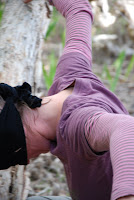SURFACE TENSIONS: Interdisciplinary Dance Practice - conference paper
Paper Draft
Presented by ROCKface – Marnie Orr & Rachel Sweeney
In an ever increasing volatile balance between human development and material resources within the present boom or bust climate, promoting an awareness of individual agency must start with whatever individual’s sensibilities are present.
‘Surface Tensions’ is a mixed media talk presented by Marnie Orr and Rachel Sweeney of ROCKface interdisciplinary performance collaboration. They address the dancing body in contemporary performance praxis as a shifting site reflecting cultural and ecological concerns, directly engaging with matters surrounding sustainability based on its ability to articulate physically a critical response to interior (anatomical) and exterior (environmental) states.
‘Surface Tensions’ cites four years of performance / dialogue exchange of interdisciplinary inquiry into site-based performance making processes interfacing contemporary choreographic research (based on Butoh and Bodyweather practice, see biographies) with disciplines of geology, cartography and environmental science. Using stills/video projections and journal extracts, this joint presentation introduces our latest project Inhabitation, beginning in Western Australia, July 2009.
Reflecting on the emigration of materials as societal action, we parallel how the performance ethos of ROCKface adapts processes of material property exchange as a work motif, exploring sensorial approaches to land through live field investigations of the dancing body in relation to its immediate surrounds.
The shifting dynamics of our transnational terrain inquiry relating to power, culture, language, audience and intensity are considered under the terms Translation, Transmission and Transformation.
Translation:// We regard ourselves as interdisciplinary ‘live researchers’, where the critical hub of ROCKface identifies processes of adaptation surrounding the body’s relation to site, subscribing to key philosophical principles underlying ‘Deep Ecology’i. Current ecological concerns look to adaptation as key to sustaining endemic mineral, animal and vegetable life through identifying possible compatible species trans-globally.
Transmission:// We outline our performance methods, focusing on the transfer of physical principles between studio and site across time and geographic distance.
Transformation:// Vital to sustaining ROCKface performance practice is the recognition of ecological integration and adaptation processes as macro/microcosms of human relations, in parallel with physical matter redistribution and changing states.
i First coined by Norwegian philosopher Arne Naess. ‘deep ecology’ describes an ecological philosophy and ethic-aware scientific approach based on the lived experience of deep, radical interconnectedness with environment. Rejecting a reductionist methodology, the worldview builds on cultural historian Thomas Berry’s position that the world is made up of “a communion of subjects rather than a collection of objects” – see Stephan Harding’s explanation in Animate Earth, Science, Intuition and Gaia, Green Books, 2006.
Furthering the movement of deep ecology is the anti-mechanistic theory of Gaia developed by atmospheric chemist James Lovelock and evolutionary biologist Lynn Margulis. Gaia theory refers to the earth as a living organism, where all things are interrelated and interdependent. Adopting these foundations, ROCKface identifies the body as constantly, simultaneously engaged with the self and the immediate surrounding environments, living the experience as embedded within the world’s ecological matrix.









